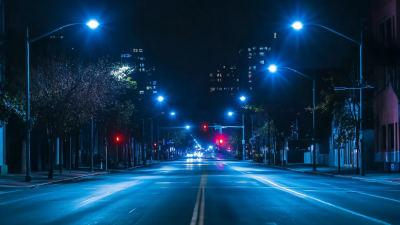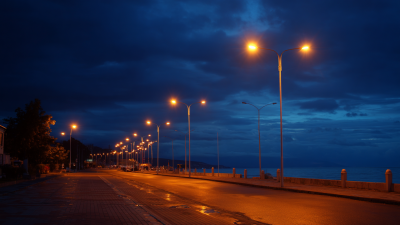7 Tips to Choose the Best LED Street Lights for Your Global Procurement Needs
In recent years, the global demand for LED street lights has surged, prompting municipalities and businesses to seek the most efficient and cost-effective solutions for their lighting needs. According to a report by the International Energy Agency, the adoption of LED street lighting can reduce energy consumption by up to 50% compared to traditional high-pressure sodium lights. Furthermore, the global smart street lighting market is expected to reach USD 30 billion by 2025, reflecting the growing trend toward energy-efficient and sustainable urban infrastructure.

As cities strive to enhance public safety and reduce their carbon footprint, selecting the right LED street lights is crucial. This blog outlines seven essential tips to help procurement professionals make informed decisions in this rapidly evolving market, ensuring that their choices align with sustainability goals and budget constraints.
Factors to Consider for Efficient LED Street Lighting Solutions
When selecting LED street lights for global procurement, several critical factors must be considered to maximize efficiency and sustainability. First, the color temperature of the LEDs plays a pivotal role in visibility and safety. According to the U.S. Department of Energy, streetlights with a color temperature between 3000K and 4000K provide optimal visibility while reducing glare, which can enhance nighttime safety for pedestrians and drivers alike.
Additionally, luminous efficacy is another crucial metric to evaluate. It measures the amount of visible light emitted per watt of energy consumed. Recent reports from the International Energy Agency (IEA) reveal that high-efficiency LED street lights can consume up to 75% less energy than traditional incandescent lamps while offering significantly longer lifespans—often exceeding 50,000 hours. These energy savings not only contribute to reduced operational costs but also support global efforts for energy conservation and greenhouse gas emission reductions.
Finally, smart technology integration is becoming increasingly important. Smart street lights equipped with sensors and IoT capabilities can dynamically adjust brightness based on real-time conditions, further optimizing energy consumption while improving urban safety. Integrating advanced technologies can lead to smarter, more responsive street lighting infrastructures that adapt to the needs of urban environments.

Evaluating Lumens and Color Temperature for Optimal Visibility
When selecting LED street lights for global procurement, one of the key considerations is understanding lumens and color temperature to ensure optimal visibility.
Lumens measure the total light output of a fixture; the higher the lumen count, the brighter the light. For street lighting, a higher lumen output is crucial to enhance safety for pedestrians and drivers alike, especially in high-traffic areas. A typical range for effective street lighting can vary, but aiming for around 7,000 to 10,000 lumens is often ideal, depending on the specific application and local regulations.
Color temperature is another critical factor, as it affects how the light appears and how visibility is perceived. Typically measured in Kelvin (K), lower color temperatures (around 3000K) emit a warm yellowish light, while higher temperatures (above 5000K) produce a cooler, bluish light. Cooler color temperatures are often preferable for street lighting because they enhance contrast and visibility, making it easier for drivers to see pedestrians and obstacles in darker conditions. Choosing the right combination of lumens and color temperature can significantly improve nighttime safety and efficiency in urban environments.
Energy Efficiency Ratings: Understanding Wattage and Lifespan
When selecting LED street lights for global procurement, understanding energy efficiency ratings is paramount. One of the key factors in assessing efficiency is wattage, which directly affects both energy consumption and operational costs. According to the U.S. Department of Energy, LED street lights can use 75% less energy than traditional high-pressure sodium (HPS) lights while providing superior illumination quality. For instance, a typical 100-watt HPS fixture may be replaced with a 30-watt LED fixture, significantly reducing energy use without sacrificing brightness.
In addition to wattage, lifespan is a critical metric that impacts the long-term value of LED street lights. Many LED models boast lifespans of 50,000 to 100,000 hours compared to only 24,000 hours for HPS lights. The Illuminating Engineering Society states that the extended lifespan of LEDs not only reduces replacement frequency and labor costs but also decreases the environmental impact associated with manufacturing and disposing of lighting fixtures. Thus, focusing on wattage and lifespan helps organizations make informed decisions that align with sustainability goals while optimizing their procurement strategies.

Durability and Weather Resistance for Long-Term Performance
When selecting LED street lights for global procurement, durability and weather resistance are paramount to ensure long-term performance. In regions with extreme weather conditions, from heavy rains to intense heat, it’s crucial to choose lighting solutions designed to withstand these challenges. Look for fixtures made from high-quality materials that have proven resistance to corrosion and impact. An IP rating of at least IP65 is essential, indicating robust protection against dust and water ingress.
Another key tip is to consider the thermal management of LED street lights. Effective heat dissipation not only prolongs the lifespan of the lights but also maintains their brightness over time. Fixtures equipped with aluminum heat sinks or built-in cooling technologies tend to perform better under high temperatures, reducing the risk of early failure. Additionally, seeking lights that come with protective features against UV rays can further enhance durability, preventing material degradation over the years.
Moreover, it’s wise to invest in fixtures that offer a warranty or guarantee for extended periods. Many reputable manufacturers provide multi-year warranties, reflecting their confidence in the product's longevity and performance. This not only ensures peace of mind but also signifies that the lights have been rigorously tested for durability in real-world conditions, making them a reliable choice for your procurement needs.
Durability and Weather Resistance of LED Street Lights
Cost-Effectiveness: Balancing Initial Investment and Maintenance Savings
When selecting the best LED street lights for global procurement, one of the most critical factors to consider is cost-effectiveness. This entails a careful analysis of both the initial investment and the long-term savings on maintenance and energy costs. Although LED lights may come with a higher upfront price compared to traditional lighting options, their energy efficiency can lead to significant reductions in electricity bills. Over time, the savings generated from lower energy consumption can far outweigh the initial costs, making LEDs a smart financial choice for municipalities and businesses alike.
Moreover, the longevity of LED street lights contributes substantially to their cost-effectiveness. These lights typically have a lifespan of 50,000 hours or more, drastically reducing the frequency and cost of replacements. Maintenance savings are another critical component, as LED fixtures require less frequent servicing due to their durability. Such a combination of lower operational costs and extended lifespan makes investing in LED street lighting not just an environmentally sustainable choice, but also a financially prudent one. By assessing these factors, decision-makers can ensure they are making informed choices that benefit both their budgets and the communities they serve.
Related Posts
-

Discover the Future of Urban Lighting at the 137th Canton Fair: Commercial LED Street Lights in Focus
-

Exploring the Future: Top 2025 Technology Trends in the Best LED Street Lights Industry
-

How to Select the Best Commercial LED Street Lights for Sustainable Urban Development
-

Navigating Challenges in Meeting Global Standards for Best Commercial Led Street Lights
-

7 Essential Benefits of Choosing Commercial Led Street Lights for Your City
-

Understanding the Advantages of Using the Best Panel Lights for Modern Spaces

